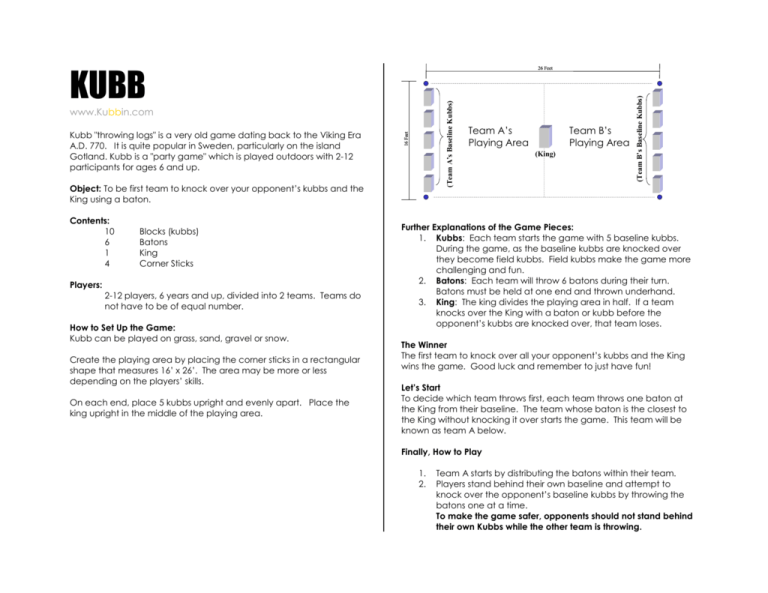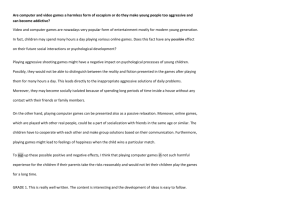Kubb "throwing logs" is a very old game dating back to the Viking
advertisement

KUBB Kubb "throwing logs" is a very old game dating back to the Viking Era A.D. 770. It is quite popular in Sweden, particularly on the island Gotland. Kubb is a "party game" which is played outdoors with 2-12 participants for ages 6 and up. 16 Feet www.Kubbin.com Object: To be first team to knock over your opponent’s kubbs and the King using a baton. Contents: 10 6 1 4 Blocks (kubbs) Batons King Corner Sticks Players: 2-12 players, 6 years and up, divided into 2 teams. Teams do not have to be of equal number. How to Set Up the Game: Kubb can be played on grass, sand, gravel or snow. Create the playing area by placing the corner sticks in a rectangular shape that measures 16’ x 26’. The area may be more or less depending on the players’ skills. On each end, place 5 kubbs upright and evenly apart. Place the king upright in the middle of the playing area. Team A’s Playing Area Team B’s Playing Area (King) (Team B’s Baseline Kubbs) (Team A’s Baseline Kubbs) 26 Feet Further Explanations of the Game Pieces: 1. Kubbs: Each team starts the game with 5 baseline kubbs. During the game, as the baseline kubbs are knocked over they become field kubbs. Field kubbs make the game more challenging and fun. 2. Batons: Each team will throw 6 batons during their turn. Batons must be held at one end and thrown underhand. 3. King: The king divides the playing area in half. If a team knocks over the King with a baton or kubb before the opponent’s kubbs are knocked over, that team loses. The Winner The first team to knock over all your opponent’s kubbs and the King wins the game. Good luck and remember to just have fun! Let’s Start To decide which team throws first, each team throws one baton at the King from their baseline. The team whose baton is the closest to the King without knocking it over starts the game. This team will be known as team A below. Finally, How to Play 1. 2. Team A starts by distributing the batons within their team. Players stand behind their own baseline and attempt to knock over the opponent’s baseline kubbs by throwing the batons one at a time. To make the game safer, opponents should not stand behind their own Kubbs while the other team is throwing. 3. 4. When team A finishes throwing all 6 batons, the Kubbs that have been knocked over, if any, are now considered field kubbs. The field kubbs are then thrown one at a time by Team B over to team A’s playing area (just past the king). When the field kubb lands within the playing area, it is raised by Team A where it rests. Field kubbs (King) In the example below, Team A knocked over 2 of Team B’s baseline kubbs, Team B then threw the field kubbs into Team A’s playing area. Field kubbs Team A’s Playing Area 5. 6. (King) Team A’s Playing Area Team B’s Playing Area Tip: If more than one field kubb is to be thrown, attempt to throw the consecutive kubbs at the raised kubb. Each field kubb that hits the raised field kubb is to be put on top in hopes of building a “tower”. This makes it easier to hit all the Kubbs in a single well-aimed throw of the baton. There are no limits to the number of kubbs that can make up the “tower”. If in the above example, the second field kubb thrown hit the raised kubb, a tower would have been created as illustrated below. Team B’s Playing Area Now it is team B’s turn to throw the batons. Team B starts by distributing the batons within their team. Before team B is able to knock over team A’s kubbs, they must knock over the field kubbs in Team A’s playing area. If team B knocks over all their field kubbs, then they attempt to knock over team A’s baseline Kubbs. Tip: Try to knock over the field kubbs closest to the “middle line” first. If you don’t knock over all the field kubbs, team A has the opportunity to throw from an imagined baseline drawn through the field kubb that is nearest the king on their next turn. This gives them a big advantage since the distance to the opponent’s kubbs is now shorter. 7. 8. 9. Team A then throws the field kubbs and any new baseline kubbs that were knocked over. The game continues until all the opponent's kubbs are knocked over. Kubbs that are knocked over the second time are out of play and removed from the playing field. Once all opponent’s kubbs are knocked over, that team can throw at the king from their baseline. When the king is knocked over, the game is won. One and only one baton is thrown in an attempt to knock down the King. If unsuccessful in knocking down the King, the opposing team continues play. Special Situations 1. If the team is unable to land a field kubb within the playing area after 2 attempts, team A may place the field kubb 2. wherever they like on their own side, preferably behind the king no closer than the length of one baton. If the baseline kubbs are knocked over while attempting to knock over the field kubbs, the baseline kubb(s) should be stood back up.






